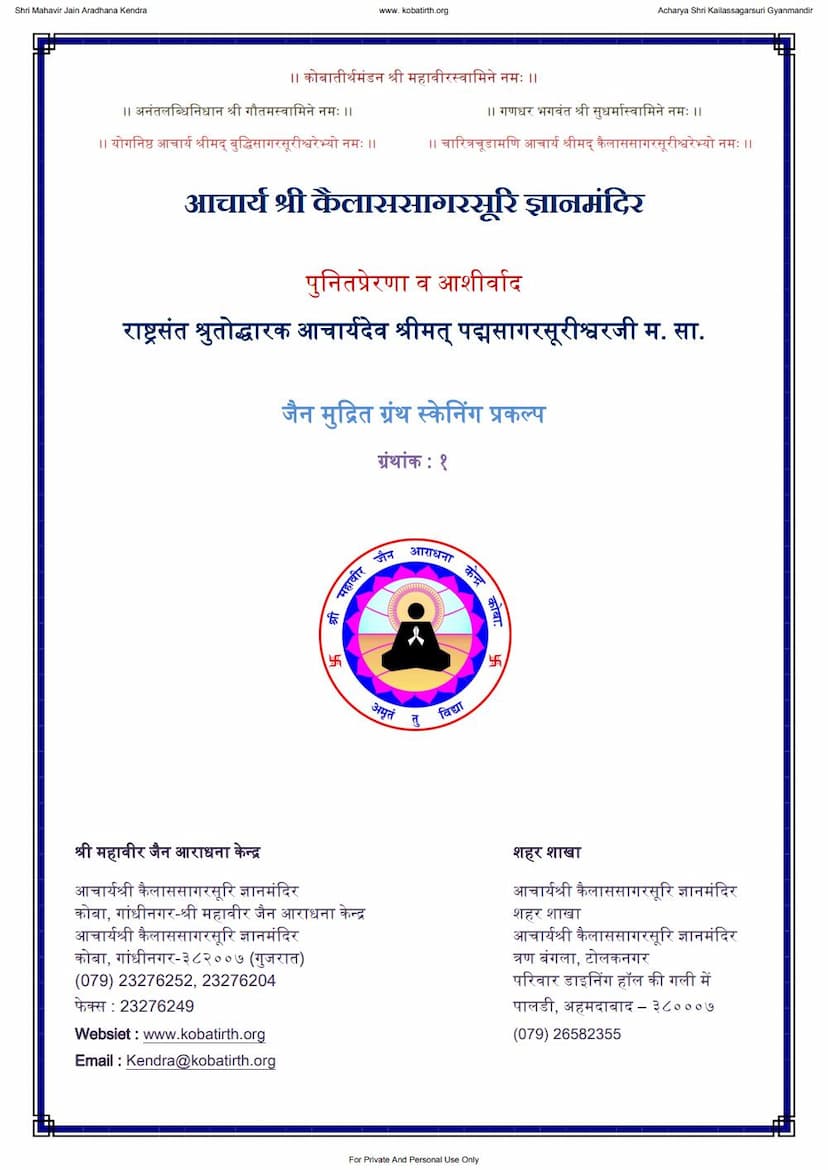Agam 25 Prakirnaka 02 Atur Pratyakhna Sutra Shwetambar
Added to library: September 1, 2025

Summary
Here's a comprehensive summary of the provided Jain text, "Agam 25 Prakirnaka 02 Atur Pratyakhna Sutra Shwetambar," focusing on its content and context:
Book Title: Agam 25 Prakirnaka 02 Atur Pratyakhna Sutra Shwetambar Author(s): Purnachandrasagar Publisher: Jainand Pustakalay Context: This document is a Jain religious text, specifically the "Atur Pratyakhna Sutra" (Aatur Pratyakhyan Sutra), which is part of the Prakirnaka section of the Agamas (scriptures) according to the Shwetambar tradition of Jainism. The text is presented with extensive introductory material and acknowledgments related to its publication and the lineage of scholars involved.
Key Themes and Content:
The core of the document is the Atur Pratyakhna Sutra, which, based on the title and the devotional verses, deals with repentance (pratikraman) and renunciation (pratyakhyana). The term "Atur" can refer to someone in distress, ill, or dying, suggesting the Sutra might offer guidance or rituals for those facing such conditions, or more broadly, for practicing mindfulness and renunciation throughout one's life.
The introductory and concluding sections reveal several important aspects:
-
Scholarly Lineage and Transmission of Knowledge:
- The text is presented as a meticulous compilation and editing effort by Acharya Shri Anandasagar Surishwarji Maharaj.
- Pujya Ganivarya Shri Purnachandrasagarji M.S. is credited with the "alekhan karya" (writing/compositional work) and is a disciple of Acharya Shri Hemchandrasagar Suri Ji.
- The publication is associated with the Shri Mahavir Jain Aradhana Kendra and the Jainand Pustakalay, Surat, highlighting an organized effort to preserve and disseminate Jain scriptures.
- Numerous other Acharyas and Munis are acknowledged for their inspiration, guidance, and support, underscoring the collaborative nature of preserving Jain tradition.
-
Importance of Agamas and Shrutgyan:
- The introductory "Prakathan" (preface) emphasizes the profound significance of Shrutgyan (knowledge gained through listening/study) in guiding souls through the cycles of birth and death.
- Agamas are described as the very word of Lord Mahavir Swami, making their preservation crucial.
-
History of Agama Recensions (Vachanas):
- A significant portion of the introductory material is dedicated to detailing the six major recensions (vachanas) of the Agamas after Lord Mahavir's Nirvana. This historical overview highlights the challenges faced in preserving the scriptures due to:
- Famines and Calamities: The text mentions the severe twelve-year famine during the time of Shri Bhadrabahu Swami, which scattered the monastic community.
- Political Upheavals: The fall of empires and persecution by rulers led to disruptions in the study and teaching of the Agamas.
- Loss of Oral Tradition: The reliance on memorization (mukhpāth) made the scriptures vulnerable to loss when learned scholars passed away.
- Need for Compilation: The recensions were attempts to systematically compile, organize, and preserve the vast body of Jain scripture, often involving the writing down of the orally transmitted texts.
- The six recensions are named and briefly described in terms of their time, location, and purpose, demonstrating the continuous effort to safeguard the Jain heritage.
- A significant portion of the introductory material is dedicated to detailing the six major recensions (vachanas) of the Agamas after Lord Mahavir's Nirvana. This historical overview highlights the challenges faced in preserving the scriptures due to:
-
Modern Revival and Publication Efforts:
- The text explicitly mentions the challenges of preserving knowledge in the 10th century onwards, with the rise of laxity and the difficulty in accessing handwritten manuscripts.
- It highlights the pivotal role of Acharya Shri Anandasagar Surishwarji Maharaj in the latter half of the 20th century in reviving the tradition of Samudayik Vachanas (communal readings/recitations) of the Agamas.
- These efforts involved collecting manuscripts, meticulous editing, and publishing limited editions of the Agamas, leading to the re-establishment of the practice of reading and studying the scriptures among monks and nuns.
-
The Atur Pratyakhna Sutra Itself:
- The sutra contains verses in Prakrit (or a related vernacular) that detail types of death, focusing on the distinction between "Bal Panditya Maran" (death of an ignorant person who has some understanding) and "Pandit Maran" (death of a wise person).
- It elaborates on the circumstances that lead to different types of rebirths and the path to liberation.
- The text then moves into the practice of pratikraman (repentance) and pratyakhyana (renunciation), including specific vows and affirmations.
- Key elements of these practices include:
- Repentance for past and future transgressions.
- Renunciation of desires, attachments, anger, pride, deceit, greed, passions, and negative activities.
- Taking vows related to non-violence, truthfulness, not stealing, celibacy (or marital fidelity), and limited possession.
- Emphasis on mindfulness, self-control, and the pursuit of spiritual knowledge.
- The ultimate goal is liberation (moksha) and the avoidance of rebirth in lower realms.
-
Publisher's Note: The concluding "Prashasti" reaffirms the publication details and credits the lineage of Acharyas and the publishing house, signifying a continuation of scholarly tradition and devotional service.
In essence, the "Atur Pratyakhna Sutra" is a Jain scripture offering guidance on spiritual practices, particularly repentance and renunciation, with a focus on understanding the nature of death and its implications for rebirth. The accompanying material underscores the historical efforts to preserve the Jain Agamas and highlights the contemporary revival and scholarly work undertaken to make these sacred texts accessible.